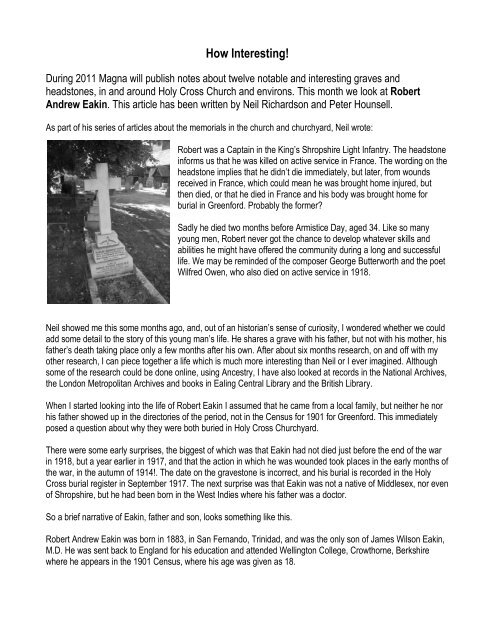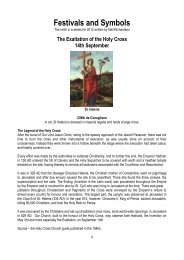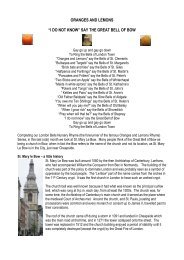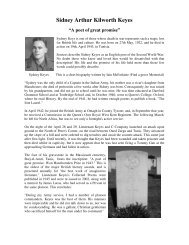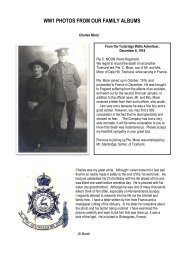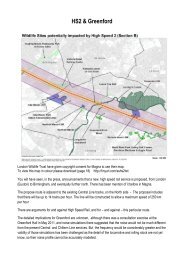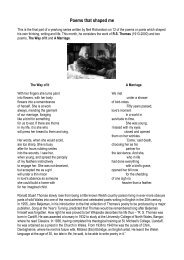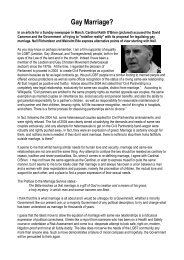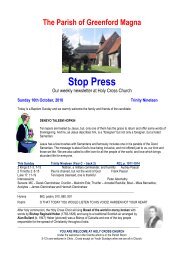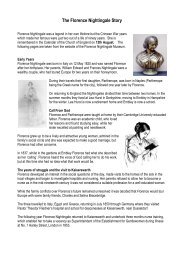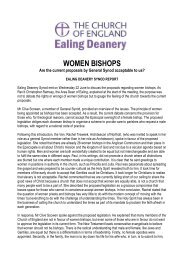Robert Andrew Eakin - The Parish of Greenford Magna
Robert Andrew Eakin - The Parish of Greenford Magna
Robert Andrew Eakin - The Parish of Greenford Magna
You also want an ePaper? Increase the reach of your titles
YUMPU automatically turns print PDFs into web optimized ePapers that Google loves.
How Interesting!<br />
During 2011 <strong>Magna</strong> will publish notes about twelve notable and interesting graves and<br />
headstones, in and around Holy Cross Church and environs. This month we look at <strong>Robert</strong><br />
<strong>Andrew</strong> <strong>Eakin</strong>. This article has been written by Neil Richardson and Peter Hounsell.<br />
As part <strong>of</strong> his series <strong>of</strong> articles about the memorials in the church and churchyard, Neil wrote:<br />
<strong>Robert</strong> was a Captain in the King’s Shropshire Light Infantry. <strong>The</strong> headstone<br />
informs us that he was killed on active service in France. <strong>The</strong> wording on the<br />
headstone implies that he didn’t die immediately, but later, from wounds<br />
received in France, which could mean he was brought home injured, but<br />
then died, or that he died in France and his body was brought home for<br />
burial in <strong>Greenford</strong>. Probably the former?<br />
Sadly he died two months before Armistice Day, aged 34. Like so many<br />
young men, <strong>Robert</strong> never got the chance to develop whatever skills and<br />
abilities he might have <strong>of</strong>fered the community during a long and successful<br />
life. We may be reminded <strong>of</strong> the composer George Butterworth and the poet<br />
Wilfred Owen, who also died on active service in 1918.<br />
Neil showed me this some months ago, and, out <strong>of</strong> an historian’s sense <strong>of</strong> curiosity, I wondered whether we could<br />
add some detail to the story <strong>of</strong> this young man’s life. He shares a grave with his father, but not with his mother, his<br />
father’s death taking place only a few months after his own. After about six months research, on and <strong>of</strong>f with my<br />
other research, I can piece together a life which is much more interesting than Neil or I ever imagined. Although<br />
some <strong>of</strong> the research could be done online, using Ancestry, I have also looked at records in the National Archives,<br />
the London Metropolitan Archives and books in Ealing Central Library and the British Library.<br />
When I started looking into the life <strong>of</strong> <strong>Robert</strong> <strong>Eakin</strong> I assumed that he came from a local family, but neither he nor<br />
his father showed up in the directories <strong>of</strong> the period, not in the Census for 1901 for <strong>Greenford</strong>. This immediately<br />
posed a question about why they were both buried in Holy Cross Churchyard.<br />
<strong>The</strong>re were some early surprises, the biggest <strong>of</strong> which was that <strong>Eakin</strong> had not died just before the end <strong>of</strong> the war<br />
in 1918, but a year earlier in 1917, and that the action in which he was wounded took places in the early months <strong>of</strong><br />
the war, in the autumn <strong>of</strong> 1914!. <strong>The</strong> date on the gravestone is incorrect, and his burial is recorded in the Holy<br />
Cross burial register in September 1917. <strong>The</strong> next surprise was that <strong>Eakin</strong> was not a native <strong>of</strong> Middlesex, nor even<br />
<strong>of</strong> Shropshire, but he had been born in the West Indies where his father was a doctor.<br />
So a brief narrative <strong>of</strong> <strong>Eakin</strong>, father and son, looks something like this.<br />
<strong>Robert</strong> <strong>Andrew</strong> <strong>Eakin</strong> was born in 1883, in San Fernando, Trinidad, and was the only son <strong>of</strong> James Wilson <strong>Eakin</strong>,<br />
M.D. He was sent back to England for his education and attended Wellington College, Crowthorne, Berkshire<br />
where he appears in the 1901 Census, where his age was given as 18.
He must have enlisted in the army soon after as he served in the South African War and was awarded the<br />
Queen’s Medal with four clasps. He was gazetted 2 nd Lieutenant, in the Lancashire Fusiliers in June 1904, and in<br />
1908 transferred to the 1 st battalion Shropshire Light Infantry.<br />
Officers <strong>of</strong> the 1 st Battalion, King’s Shropshire Light Infantry taken in 1913. <strong>Eakin</strong> is apparently the third from the left in the<br />
middle row. (Photo courtesy <strong>of</strong> the Regimental Museum at Shrewsbury).<br />
Of his military service we know very little, save that he played military cricket, according to Wisden. His battalion<br />
was serving in Ireland when hostilities started in 1914, so for him and his colleagues on the Western Front they<br />
had come a long way from Tipperary, as the battalion left there on the 14 th August on its way to France via<br />
England.<br />
<strong>The</strong> battalion joined the 16 th Infantry Brigade and at the end <strong>of</strong> August were encamped at Grantchester near<br />
Cambridge. (If you enjoy such associations, Grantchester was for a time before the 1 st World War the home <strong>of</strong><br />
Rupert Brooke, who wrote about the “corner <strong>of</strong> a foreign field that is for ever England”, and died near Gallipoli).<br />
From there they set <strong>of</strong>f for France and were marching towards Crecy – think <strong>of</strong> the associations with wars long<br />
ago! - on 12 th September. <strong>The</strong> battalion was then engaged in some <strong>of</strong> the early encounters <strong>of</strong> the war, and it was<br />
at the battle <strong>of</strong> Le Quesne on 22 nd October that Lieutenant <strong>Eakin</strong> was one <strong>of</strong> several casualties, according the<br />
battalion’s <strong>of</strong>ficial war diary. From later information we know that his cause <strong>of</strong> death, three years later, was a<br />
gunshot wound to the head, but the nature and extent <strong>of</strong> his original injury is not recorded. However, it was <strong>of</strong><br />
sufficient severity to prevent his rejoining his regiment although he remained on the army payroll.<br />
Whilst injured he was promoted temporary captain in November that year. He was clearly unfit for further military<br />
service, but there is no evidence <strong>of</strong> when and where he was in hospital. However, he was fit enough to travel to<br />
Trinidad in February 1915, presumably to visit his father, returning in March. <strong>The</strong>re is no information about what he<br />
was doing in the period between 1915 and 1917, but he married on 5th May 1917 Kate (Kitty) Emily Phillips, aged<br />
25, the daughter <strong>of</strong> <strong>Robert</strong> William Phillips (deceased). At the time <strong>of</strong> his marriage his address was given as 83<br />
Portland Place, his wife’s as Weymouth Court, Portland Place. <strong>The</strong> wedding took place at Holy Trinity, Marylebone<br />
Road. I have not been able to find any evidence about how and where they met. When next we catch a glimpse <strong>of</strong><br />
<strong>Robert</strong>, he has died <strong>of</strong> wounds on 24 th September 1917 at the Royal Victoria Hospital, Netley, a military hospital<br />
near Southampton. His wife was apparently present at his death, which was registered at South Shoreham.
<strong>The</strong> funeral took place at <strong>Greenford</strong> Church at 12 noon on Friday 28 th September 1917. <strong>The</strong>re was no report <strong>of</strong> the<br />
funeral in the local paper. A year later, on the anniversary <strong>of</strong> his death, his widow placed an “In memoriam” piece<br />
in the Times <strong>of</strong> Tuesday 24 th September. It contained the verse:<br />
<strong>The</strong> little mighty force that stood for England<br />
Stood firm, while England girt her armour on.<br />
<strong>The</strong> quotation comes from a poem To the Vanguard by Beatrix Brice which commemorates the role <strong>of</strong> England’s<br />
small pr<strong>of</strong>essional army at the beginning <strong>of</strong> the war – the so-called Old Contemptibles.<br />
As well as his headstone at <strong>Greenford</strong>, <strong>Robert</strong> is commemorated on the Port <strong>of</strong> Spain Cenotaph and in the<br />
Caribbean Roll <strong>of</strong> Honour.<br />
His probate recorded his home address as Clare Hall, South Mimms. Administration was granted on 9th<br />
December 1917 to his widow, and he left an estate worth £973 – 12s – 4d. Kate <strong>Eakin</strong> applied for her husband’s<br />
medals in May 1921. She remarried in 1924, to Ralph Philipson, an insurance broker. He died in 1963, and she<br />
died in 1967, aged 76, at Chapel-en-le-Frith in Derbyshire.<br />
As we have seen that <strong>Eakin</strong>’s father, who died in 1919, shares a grave with him in <strong>Greenford</strong> churchyard. James<br />
Wilson <strong>Eakin</strong> was born c.1854 and had trained as a doctor in Dublin, and was included on the General Medical<br />
Register in 1875. He served as a ship’s doctor with P & O in 1879, before settling in Trinidad with his first wife. He<br />
was a member <strong>of</strong> the British Medical Association and became treasurer <strong>of</strong> the Trinidad & Tobago branch in 1892,<br />
and President in 1895.<br />
He was in London, staying at the Portland Hotel, in 1912 when he married for a second time, aged 58. <strong>The</strong><br />
wedding took place at All Souls, Langham Place on 27 th June, and his new wife was a widow Maud Edith Sarah<br />
Ellis, aged 49, whose address was given as Northfleet in Kent. However, this marriage was not to be a long one,<br />
as she died in Port <strong>of</strong> Spain in August 1914.<strong>The</strong>y had both travelled back to England on the Royal Mail Steam<br />
Packet “Danube” arriving in Southampton on 13 April 1914.<br />
Following his son’s visit to Trinidad early in 1915, <strong>Eakin</strong> senior travelled back to England arriving in London on 16 th<br />
June. At the time <strong>of</strong> his death his address was also given as Clare Hall, South Mimms. I originally thought this was<br />
the name <strong>of</strong> a private house, but in fact it was a hospital, operated by Middlesex County Council, originally to treat<br />
smallpox patients, but at this period and later, a T.B. sanatorium. <strong>Eakin</strong> was appointed Assistant Medical<br />
Superintendent <strong>of</strong> the hospital at a salary <strong>of</strong> £120 p.a. in February 1916 and he remained at Clare Hall until his<br />
death. He suffered some major medical event shortly after his son’s death, which resulted in a total loss <strong>of</strong> sight,<br />
making any continuance <strong>of</strong> his medical duties impossible. He was allowed to continue living in his quarters at the<br />
hospital, and a charge <strong>of</strong> 30s a week was levied for his board, lodging and laundry. He died on 25 February 1919<br />
at Clare Hall and his death was registered at Barnet. He was buried at <strong>Greenford</strong> three days later. Probate was<br />
given on 17th July 1919 to Charles Ta Bois M.D., the Medical Superintendent at Clare Hall in the amount <strong>of</strong><br />
£6836-11s-8d. Neil commented, thinking that <strong>Eakin</strong> senior had died shortly after his son, that grief may had been<br />
part <strong>of</strong> it. Although the gap between the two deaths is a year longer than it appeared because <strong>of</strong> the incorrect date<br />
on the gravestone, nonetheless the records <strong>of</strong> Clare Hall record that James’s breakdown and blindness followed<br />
only a few weeks after the board had <strong>of</strong>fered their condolences on the death <strong>of</strong> his son, so Neil’s supposition may<br />
well be correct.
A number <strong>of</strong> questions remain. <strong>The</strong> first relates to the nature <strong>of</strong> <strong>Eakin</strong>’s wounds and what happened in 1917 that<br />
occasioned his death three years after he was originally wounded. Unfortunately, <strong>Eakin</strong>’s army file only records his<br />
“afterlife”, as the first entry in the file is the notification <strong>of</strong> his death, and the rest <strong>of</strong> the file is concerned only with<br />
the amount <strong>of</strong> pay arrears owed to his widow. <strong>The</strong> second question is why are the <strong>Eakin</strong>s both buried at<br />
<strong>Greenford</strong>?<br />
When <strong>Robert</strong> returned from the West Indies in March 1915 he gave his address in England on the shipping<br />
register as <strong>Greenford</strong> Green, Harrow, Middlesex and this address is also given by his father when he made the<br />
journey three months later. So did <strong>Robert</strong> <strong>Eakin</strong> own or rent a house at <strong>Greenford</strong> or was he staying with friends?<br />
Was it possible that <strong>Eakin</strong> senior knew Dr George Leslie Eastes who lived there, although they hadn’t trained<br />
together? In fact the connection was a simple one, once I had investigated the history <strong>of</strong> <strong>Eakin</strong>’s regiment. One <strong>of</strong><br />
his fellow <strong>of</strong>ficers when the battalion arrived in France in 1914 was Lieutenant T.D. Perkin. Like <strong>Eakin</strong> a regular<br />
soldier, Perkin was the son <strong>of</strong> Alfred William Perkin J.P., nephew <strong>of</strong> William Henry Perkin, the pioneering chemist<br />
who made the first chemical dyes at <strong>Greenford</strong> in the 1860s. A.W. Perkin was heavily involved in local affairs and<br />
served, amongst other appointments, as chairman <strong>of</strong> the Board <strong>of</strong> Management <strong>of</strong> Clare Hall throughout the<br />
period <strong>of</strong> James <strong>Eakin</strong>s’ involvement. So we may reasonably assume that <strong>Robert</strong> <strong>Eakin</strong>’s friendship with Thomas<br />
Perkin brought him to <strong>Greenford</strong>, and later his father followed him there. Perkin was injured in 1915, but survived<br />
the war as adjutant to the Reserve Battalion, and was living back in <strong>Greenford</strong> after the war.<br />
Neil originally quoted a passage from Wilfred Owen’s poem Dulce et Decorum est<br />
My friend, you would not tell with such high zest<br />
To children ardent for some desperate glory<br />
<strong>The</strong> old lie; Dulce et Decorum Est<br />
Pro patria mori.<br />
Wilfred Owen<br />
Perhaps one could add another epigraph, which appears in a history <strong>of</strong> the KSLI in the Great War, published in the<br />
1925, <strong>of</strong> which T.D. Perkin was one <strong>of</strong> the subscribers. It is a passage from A.E. Housman’s sequence <strong>of</strong> poems,<br />
A Shropshire Lad, which though published in 1896, now seems so prescient <strong>of</strong> the loss <strong>of</strong> young lives in the First<br />
World War. <strong>The</strong>se words were memorably set to music by George Butterworth.<br />
Peter Hounsell<br />
<strong>The</strong>y carry back bright to the coiner the mintage <strong>of</strong> man,<br />
<strong>The</strong> lads that will die in their glory and never be old.


